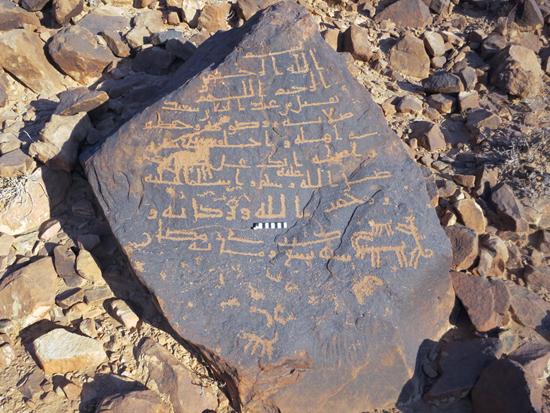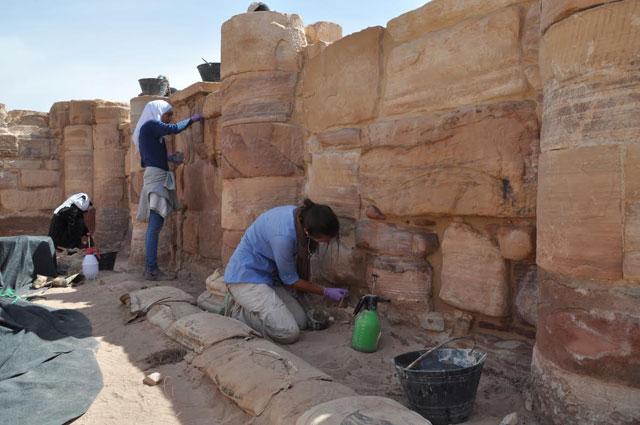You are here
US, Jordanian scholars bring attention to forgotten ancient mosque in Wadi Shireh
By Saeb Rawashdeh - Sep 06,2015 - Last updated at Sep 06,2015

In this recent photo, Kufic inscriptions are seen at the site of Wadi Shireh mosque, which dates back to the Umayyad era (Photo courtesy of Glenn Corbett)
AMMAN — Two scholars from the American Centre of Oriental Research (ACOR), Glenn Corbett and Firas Bqain, have spent years studying an often overlooked archaeological site in Wadi Rum in the Kingdom’s south.
The site is a desert mosque and way station from the time of the Umayyads (7th-8th centuries) found in the remote Wadi Shireh.
Their work follows in the footsteps of the late William Jobling of the University of Sydney who in the 1980s identified important archaeological remains in Wadi Shireh, including the early mosque.
“We were not the first to discover or study the mosque site in Wadi Shireh,” said Corbett, who holds a PhD in Near Eastern archaeology from the University of Chicago and now serves as ACOR’s associate director.
“It was first discovered and documented [by Jobling] in 1988 during the Aqaba-Maan Archaeological and Epigraphic Survey.”
Jobling did not excavate the Shireh mosque, but recorded what remained on the surface, as well as a number of early Islamic inscriptions surrounding the site.
“Fortunately, the mosque, its inscriptions and the surrounding structures are all still visible when walking through the wadi [valley],” Corbett said.
“Jobling’s preliminary reports on the mosque attracted the attention of several Arab and foreign scholars, most of whom focused their attention on the site’s very interesting Kufic inscriptions, one of which is dated to the month of Ramadan in the year 109 Hijri [or December 727/January 728 AD],” he added.
These included Oxford scholar Robert Hoyland, who published the dated inscription in the journal Jerusalem Studies in Arabic and Islam, as well as a few Jordanian researchers, some of whom published articles in the annual publication of the Jordan Department of Antiquities and the University of Jordan’s journal Dirasat.
One of those Jordanian scholars was Bqain, now ACOR’s administrator, who in 2004 wrote his University of Jordan master’s thesis on the Shireh mosque.
In 2012, Corbett and Bqain began working together to bring the Umayyad mosque of Wadi Shireh to the attention of the wider academic community.
They have also sought to understand the mosque, its inscriptions and related structures in a broader historical, archaeological and environmental context.
As Corbett explained, “seasonal water pools located near the mosque provide ready access to water. Based on the mosque’s foundational Kufic inscription, which ascribes its building to one Salamah Ibn Rawh, we believe the mosque and way station were established by leading figures of Judham, the dominant tribe of the Hisma [desert] that was closely allied with the Umayyads and also benefited greatly from taxing the trade and pilgrimage caravans that passed through the region.”
Their effort paid off this summer when they published a paper titled “An Umayyad-era mosque and desert way station from Wadi Shireh, Southern Jordan” in the Journal of Islamic Archeology, Vol 2, No 1(2015).
Related Articles
AMMAN — William Jobling, the late professor at the University of Sydney, was the head of the Aqaba-Maan Archaeological and Epigraphic Survey
AMMAN — Given the numerous threats facing archaeological and cultural heritage sites in Jordan and the region, whether from war, development
AMMAN — Archaeological work in Jordan must place local communities at the heart of conservation and protection efforts, a researcher with ov















